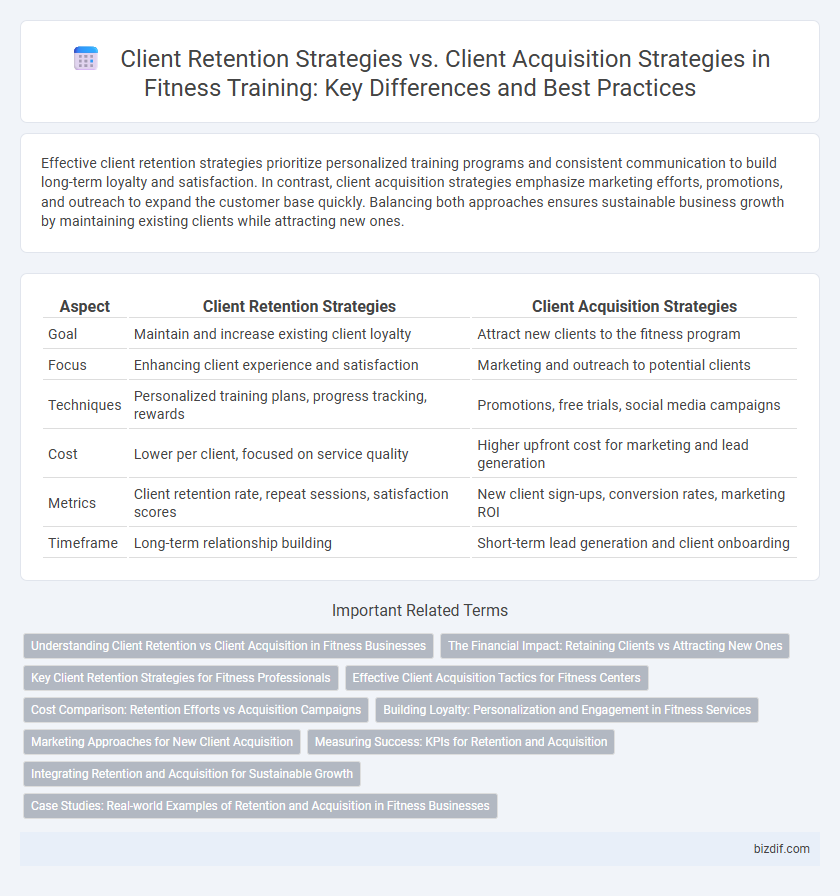Effective client retention strategies prioritize personalized training programs and consistent communication to build long-term loyalty and satisfaction. In contrast, client acquisition strategies emphasize marketing efforts, promotions, and outreach to expand the customer base quickly. Balancing both approaches ensures sustainable business growth by maintaining existing clients while attracting new ones.
Table of Comparison
| Aspect | Client Retention Strategies | Client Acquisition Strategies |
|---|---|---|
| Goal | Maintain and increase existing client loyalty | Attract new clients to the fitness program |
| Focus | Enhancing client experience and satisfaction | Marketing and outreach to potential clients |
| Techniques | Personalized training plans, progress tracking, rewards | Promotions, free trials, social media campaigns |
| Cost | Lower per client, focused on service quality | Higher upfront cost for marketing and lead generation |
| Metrics | Client retention rate, repeat sessions, satisfaction scores | New client sign-ups, conversion rates, marketing ROI |
| Timeframe | Long-term relationship building | Short-term lead generation and client onboarding |
Understanding Client Retention vs Client Acquisition in Fitness Businesses
Client retention in fitness businesses involves maintaining long-term relationships through personalized training programs, consistent communication, and member engagement, which directly increases lifetime value and brand loyalty. Client acquisition focuses on attracting new members via targeted marketing campaigns, promotions, and introductory offers designed to raise brand awareness and drive initial sign-ups. Understanding the balance between retention and acquisition enables fitness centers to optimize revenue streams by reducing churn rates while continuously expanding their customer base.
The Financial Impact: Retaining Clients vs Attracting New Ones
Client retention strategies in fitness training yield higher long-term profitability by reducing marketing expenses and increasing lifetime customer value, with retained clients generating up to 7 times more revenue than new clients. Acquisition strategies often require significant upfront costs, including promotional campaigns and onboarding, which can strain budgets without guaranteed returns. Prioritizing retention boosts steady cash flow, enhances brand loyalty, and maximizes financial efficiency compared to the unpredictable expenses of attracting new clients.
Key Client Retention Strategies for Fitness Professionals
Focusing on personalized training programs and consistent progress tracking significantly enhances client retention for fitness professionals by meeting individual needs and demonstrating tangible results. Building strong relationships through regular communication, feedback, and motivational support creates loyalty and reduces client dropout rates. Offering loyalty rewards and referral incentives encourages long-term commitment and expands the client base organically while maintaining high satisfaction.
Effective Client Acquisition Tactics for Fitness Centers
Effective client acquisition tactics for fitness centers include targeted digital marketing campaigns, leveraging social media platforms to showcase success stories, and offering trial memberships or free classes to attract new clients. Utilizing data-driven insights to tailor promotional offers and optimize advertising spend enhances conversion rates. Collaborating with local businesses and influencers also increases visibility and drives foot traffic to the facility.
Cost Comparison: Retention Efforts vs Acquisition Campaigns
Retention efforts in fitness training typically cost 5 to 25 times less than acquisition campaigns, making them more cost-effective for long-term revenue. While acquisition strategies demand significant investment in marketing, promotions, and onboarding, retention relies on personalized services and engagement, which incur lower expenses. Prioritizing client retention enhances lifetime customer value and reduces the financial burden compared to constantly attracting new clients.
Building Loyalty: Personalization and Engagement in Fitness Services
Personalization and engagement in fitness services significantly boost client retention by tailoring workouts and communication to individual goals and preferences, fostering a strong emotional connection. Strategies such as customized fitness plans, progress tracking apps, and regular interactive check-ins increase client satisfaction and long-term loyalty. Prioritizing these approaches over constant client acquisition reduces churn rate and maximizes lifetime customer value in the fitness industry.
Marketing Approaches for New Client Acquisition
Marketing approaches for new client acquisition in fitness training emphasize targeted advertising, social media campaigns, and promotional offers to attract potential clients. Leveraging SEO-optimized content and referral programs enhances visibility and credibility, drawing in a broader audience. Effective use of data analytics helps tailor messaging and optimize outreach efforts to convert leads into committed clients.
Measuring Success: KPIs for Retention and Acquisition
Measuring success in fitness training requires distinct KPIs for client retention and acquisition, such as client churn rate, average session frequency, and customer lifetime value for retention. Acquisition KPIs focus on metrics like conversion rate, cost per lead, and new client growth to assess marketing effectiveness. Tracking these specific indicators helps optimize strategies for maintaining loyal clients while efficiently gaining new members.
Integrating Retention and Acquisition for Sustainable Growth
Combining client retention strategies with client acquisition approaches creates a robust framework for sustainable growth in fitness training businesses. Retention efforts such as personalized coaching, loyalty programs, and consistent progress tracking enhance client satisfaction and lifetime value. Simultaneously, targeted acquisition campaigns optimized through data analytics ensure a steady influx of new clients, balancing growth and profitability effectively.
Case Studies: Real-world Examples of Retention and Acquisition in Fitness Businesses
Case studies from leading fitness businesses demonstrate that client retention strategies, such as personalized workout plans and loyalty programs, result in increased lifetime customer value and reduced churn rates. In contrast, client acquisition strategies often rely on targeted digital marketing campaigns and promotional offers to rapidly expand the customer base but can incur higher costs per acquisition. Analyzing these real-world examples highlights that balancing both approaches with emphasis on retention typically leads to sustainable revenue growth in the fitness industry.
Client Retention Strategies vs Client Acquisition Strategies Infographic

 bizdif.com
bizdif.com